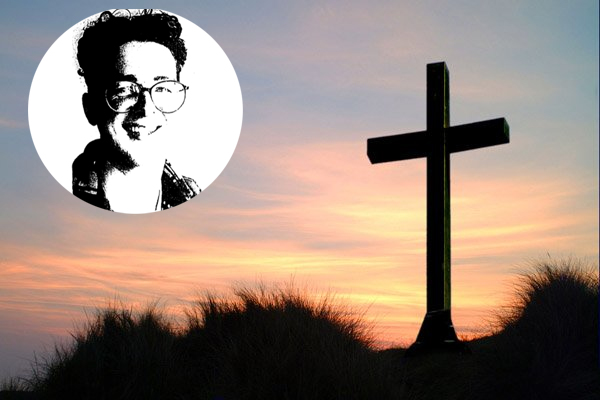Twenty-five years ago this month, a young Letterkenny voluntary missionary worker was brutally murdered in Africa.
Niall McMenamin (23), is still fondly remembered in his native town, county and country, but also in Entasekra, Kenya, where he met his tragic death.
The affable young man was Project Manager in Entasekera just outside Nairobi and was given the responsibility for designing and building a medical centre which was being built by the Holy Rosary Sisters to cater for the local population.
Located in the remote area of South Central Kenya, this district could not be reached by public transport which meant the long and difficult journey to the nearest hospital often resulted in the needless death of patients.
Niall, employed 40 local young men to build the Medical Centre paying them fairly and treated them equally which was a first for many. Niall with his strong sense of fairness would purchase large bags of maize and rice in Nairobi, transport it himself back to Entasekera (as public transport was non-existent) where he sold it back to the locals at cost price. This was an unheard of practice and one which some thought would lead to negative repercussions for Niall.
On the morning of August 24, 1993, Niall was brutally murdered in Entasekera, aged just 23 years old.
He had just returned from Ngong to collect a double week’s wages for his workers, discovered the money had not been transferred and returned empty-handed. Niall was confronted by a man who held a gun to one of the worker’s heads demanding money.
Niall kept him talking, moved closer, grabbed the gun and threw it away pinning the man down. Niall didn’t know the man had a knife which he pulled out stabbing him three times in the hand. Niall backed off giving the man time to retrieve his gun.
He fired one shot hitting Niall. Niall’s friend and local priest Fr Paul Nakisi caught him in his arms and it is there that Niall died.
The gunman continued to shoot aimlessly around him injuring a few but no one else was fatally injured; he was later arrested.
That day Niall’s body was removed from Entasekera by one of the Holy Rosary nuns Sister Celine, who travelled to the nearest morgue in Nairobi city.
In this emotional and heartfelt piece, his sister, Karen Hagney, who lives in Falcarragh, tells us about Niall’s early life, his decision to do voluntary work in Africa, how he met his death, the funeral in Letterkenny and how is remembered today.
Niall was born on the 20th of November 1969 in Letterkenny. He was the 5tthh child in a family of 7 children, born to parents Eddie & Lily, brother to Martin, Mary, Edward, Louise, Aisling & Karen.
Niall had a wonderful personality; he was witty, fun and full of ‘diviliment’. His childhood was spent in College Road playing in the grounds of St Eunan’s College, playing football and swimming in the local pool where he taught the younger family members to swim. Niall had great patience and determination and spent weeks systematically teaching our sister Louise who has an intellectual disability to ride her bike with great success.
Niall attended Scoil Colmcille (Boys School) and went on to attend St Eunan’s College.
Niall was a talented footballer who played school-boy soccer for Glencar at various ages and Gaelic for St Eunan’s. He loved both sports and was an avid follower of both Irish and English Premiership Football.
Unfortunately, during a particularly rough football match Niall had his leg broken in three places which meant he could never play football to the level he was used to again.
However, he continued to follow both soccer and Gaelic football throughout his life and took great pride in Ireland’s success in the 1990 World Cup but above all Donegal’s All Ireland win in 1992.
At school, Niall was quite academic particularly in Maths, Geography and Technical Drawing. Niall and his Geography teacher Eddie Harvey had a shared interest in African life and when Niall originally moved to Tanzania; he began writing and sending photographs to Eddie and his class regularly updating them about how his building work was going and what life was like as a missionary.
It was in the Winter of 1984 when Niall started to take a keen interest in Africa. The media was full of images of the plight of starving Ethiopians, and Band Aid released the infamous song ‘Do They Know It’s Christmas’. As a 15 year old boy, he was shocked and saddened by the images he was seeing on TV and from that young age was already showing an interest in helping those in famine stricken areas.
After his Leaving Certificate in 1987; Niall went on to study Technical Drawing & Construction Studies at Donagh O’ Malley Technical College, now LYIT. He thrived in this environment and studied hard to achieve a Distinction. He applied for and was accepted on a degree course with the University of Ulster, Jordanstown but decided to defer and pursue his dream of working in Africa. Niall felt it would be more beneficial if he could use the skills learned during his studies to improve the lives on a practical level of the African people.
After some research, Niall joined the Voluntary Missionary Movement (VMM), a Catholic Organisation with missions throughout the developing world. Niall trained in London for a number of months with a group of individuals from various backgrounds and experiences but all with the shared interest of working in Africa.
It was during this training that Niall was paired with English man Tony Hester, who had construction experience from his family’s business. They were assigned a job in Tanzania; however when they got there the money had run out for the original project so instead they began to build staff houses and toilets. They were frustrated by this as it was not the work they were originally planning to do. Despite this, they remained at it for a year before Niall moved to Entasekera, Kenya.
Throughout this period and the duration of Niall’s time in Africa, he wrote to all his family on a regular basis. His letters were diary-like, meticulously detailing the work he was doing, his frustrations of being involved with VMM and his love of the African people. He forwarded photographs of the project he was working on and the many friends he made through his missionary work.
Niall later took on the role as Project Manager in Entasekera just outside Nairobi and was given the responsibility for designing and building a medical centre which was being built by the Holy Rosary Sisters to cater for the local population. Located in the remote area of South Central Kenya, this district could not be reached by public transport which meant the long and difficult journey to the nearest hospital often resulted in the needless death of patients.
Niall employed 40 local young men to build the Medical Centre paying them fairly and treated them equally which was a first for many. Niall with his strong sense of fairness would purchase large bags of maize and rice in Nairobi, transport it himself back to Entasekera (as public transport was non-existent) where he sold it back to the locals at cost price. This was an unheard of practice and one which some thought would lead to negative repercussions for Niall.
Ngong, Entasekera in the Loita District of Kenya is where Niall felt most at home; not just from a work point of view but from the local people and fellow missionaries he worked and lived with. Niall became a well-known part of the community and became fluent in Swahili, embracing African culture and food. In return, the local community took a great interest in his Irish culture and there was always a Donegal flag and Tricolour flying. Niall didn’t need to be asked twice to sing and would belt out Christie Moore and Mary Black songs at the drop of a hat. Niall’s shared his love of football with the locals by setting up a football team….but Niall was set apart from them by one thing: they all played barefoot. In one letter he describes the young men as “having great skill but were very rough on the field”.
It would be misleading to paint Niall’s life in Africa as idyllic or perfect. He encountered many dangers, challenges and barriers on a regular basis and sometimes wrote of his frustration in dealing with a hierarchical system. Niall also dealt with two bouts of serious illness. The first he contracted Belharzia from local drinking water and then, more seriously Malaria in early 1992. This took its toll on him physically but he was well cared for by his two doctor friends from America and the nuns on the mission. He was even able to make a surprise trip home in 1992 for his brother Eddie’s wedding. Niall simply just walked up the drive of our home in College Road as if he was never away….no pomp or ceremony needed.
In spite of his illnesses he continued to work hard and aimed to complete his work on the medical centre in early Summer of 1993 but was asked to extend his contract until the following Christmas; when he was coming home to introduce us to his American girlfriend Sandy Grady whom he had met in Kenya. But as events transpired, Niall did not return home from Africa alive and we were to be introduced to Sandy under very different circumstances.
On Tuesday morning the 24th of August 1993; Niall was murdered in Entasekera, aged just 23 years old. He had just returned from Ngong to collect a double week’s wages for his workers, discovered the money had not been transferred and returned empty-handed.
It was the following day our father took the call to be told the devastating news. The details at that stage were sketchy but we were made aware that Niall was confronted by a man who held a gun to one of the worker’s heads demanding money. Niall kept him talking, moved closer, grabbed the gun and threw it away pinning the man down. Niall didn’t know the man had a knife which he pulled out stabbing him three times in the hand. Niall backed off giving the man time to retrieve his gun. He fired one shot hitting Niall. Niall’s friend and local priest Fr Paul Nakisi caught him in his arms and it is there that Niall died.
The gunman continued to shoot aimlessly around him injuring a few but no one else was fatally injured; he was later arrested.
That day Niall’s body was removed from Entasekera by one of the Holy Rosary nuns Sister Celine, who travelled to the nearest morgue in Nairobi city. This was no mean fete given the road and weather conditions and she was on her own. She wanted to ensure Niall’s body was preserved correctly so had to act quickly.
The aftermath of Niall’s death was a whirlwind of organising, dealing with the media and the pure grief we as a family felt. Our focus was on getting Niall’s remains home. Martin and Eddie made the harrowing journey to Kenya to organise this and to attend some of the services organised by the community in Entasekera. The nuns who worked with Niall had very considerately gathered all his items together, cut a lock of his hair and laundered the clothing he was wearing on the day of his death. They meticulously gathered items belonging to him whom they knew would bring comfort to us. Heartfelt stories of Niall’s life were re-called and songs, poems and stories recited.
It was a week after Niall was murdered that his remains were returned to Ireland. At Dublin Airport, a large group of family, friends and representatives from the Department of Foreign Affairs convened to meet the family and offer their condolences. His remains were escorted by Gardai to the border at Aughnacloy and there the RUC took over and accompanied the cavalcade to the border at Lifford.
Letterkenny main street was closed to allow Niall’s remains travel through the town he loved and was so proud of and the community lined the street towards our home in College Road. The outpouring of grief was at an incomprehensible scale and the wake saw thousands of people attend our home to sympathise. Our kind neighbours and friends gathered in unity and took over all responsibility for providing food and refreshments for those who came.
During that time we received hundreds of letters and cards of sympathy from all over the world. People were deeply shocked that such a young man, doing missionary work could be murdered. We heard many anecdotes of Niall’s time in Africa from friends who worked with him and it was a time of fond recollection but of great sadness for everyone concerned. There were many stories involving Niall which showed his strength of character and infectious humour in what were very challenging times. It is sometimes difficult to comprehend the serious and complicated issues Niall dealt with in his role as Project Manager and to remember how young he was. He had a level of maturity and insight far beyond his young age and his opinions and actions were trusted by the community he was serving.
In 1995 our father Eddie was asked onto the Late Late Show with Gay Byrne to join a panel of people who had experienced the murder/disappearance of a loved one. Dad spoke eloquently about Niall and specifically about our family’s response to his murder. We felt it was in our own best interest to focus on all the good work Niall had done and the difference he had made to so many people’s lives and to forgive the man who murdered him; which we have done.
The work Niall started in Entasekera on the medical centre was finished by the many missionaries and locals who gave their time to the project following Niall’s death. We previously received a letter from a German Doctor who worked at the medical centre, who never met Niall but who knew about the work he had done and was testament to the legacy he had left.
There remains a huge loyalty towards Niall and none more so than from the group of friends he grew up with in Letterkenny. These friends remained devoted to him throughout school, into his college life on to when he made the decision to work in Africa. They wrote to him regularly keeping him up to date with local news and sport and very poignantly; their true friendship came in the form of supporting our parents and us after Niall’s death. Every few weeks following Niall’s death they visited and brought laughter and hope back into our home. To this day their loyalty continues and he is remembered in their own quiet and modest way….. but it has not gone unnoticed. Thank you Danny, Johnny, TK, Brendan, Bryan, Andrew, Garrett, Tommy & Orla.
It is 25 years since Niall’s death and there is not a day goes by that we do not think of him; his spirit continues to live on in our lives, in our own families and that of his friends. Sadly both our parents have passed away but they had huge pride for all that Niall had achieved and the hope he brought to so many; which heartbreakingly ended in him paying the ultimate price for.
Karen Mc Menamin Hagney.
_____________________________________________________________________
Niall (written by Sr Gabriel Mary, Kenya)
He was young,
And only lines of laughter told of joy,
Which issued forth from him,
And sparked our day with fun.
Because he came to us, and lived with us,
He made the world a better place for us.
On that last eve, I saw him,
As he sat and read his post,
“So many wrote”, he said “and all the news is good”
All are well, I am so happy, very so!
To us he gave a gift of hope,
Else why do we remember him,
Or why do we recall, with tears, him
We met, and how we laughed and joked.
But now, he has gone! He who was so strong.
He who was a light, which now
Must not be quenched.
Across the Loita Plains,
And down the years to come,
His name will ring, Niall!
Our loved and cherished one.
And in our hearts,
His light will shine, and challenge us,
Time will take the pain away,
And only memories will stay,
While those he loved, will tell
The tale of how he was,
And praise our God, for
Gifting us with Niall.








